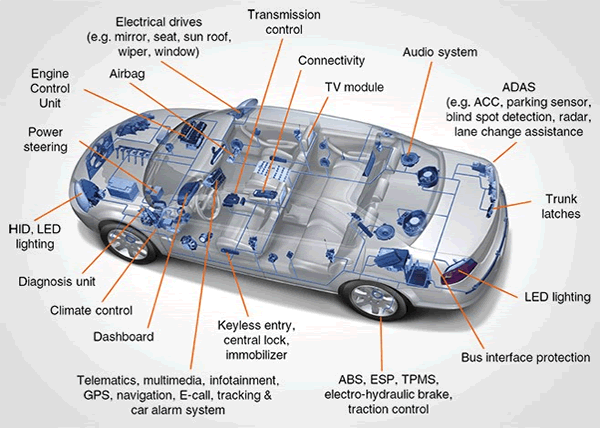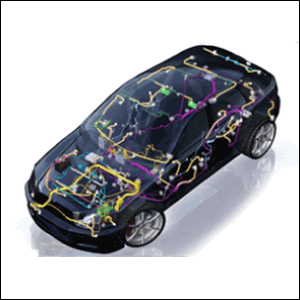Automotive Connectivity Evolves to Meet Demands for Speed & Bandwidth
Autonomous vehicle technology is driving the need for increased speed and bandwidth in electronic connectors.

The Evolution of Automotive Connectivity: Autonomous Vehicle Technology Drives the Need For Both Speed and Bandwidth
Automotive electronics have come a long way since the Ford Model T entered the market as the first mass-produced automobile in America more than 100 years ago. While the basic concept of automobiles has remained consistent, their electronics have evolved along with consumer demand for ever-improved performance, efficiency, safety, and functionality. In the earliest days of the automotive industry, connectors were primarily used for simple power linkages for the battery, alternator, and generator; to carry electrical signals linking switches to headlights, windshield wipers, and climate controls; and for basic instruments like speedometers.
Automotive designs have since evolved to include a variety of next-generation automotive systems that require increasingly specialized connectivity, such as infotainment systems and advanced driver assistance systems (ADAS), both of which are quickly becoming standard features on many late-model vehicles. Additionally, due to the meteoric rise in the research and development of autonomous vehicles, connectors and connectivity are facing more challenges and specialization with the exponential increase in the connector’s ability to deliver high-speed, high-bandwidth, and high-power signals to and from every sensor in a given vehicle.
Growth of electronic systems has driven connector evolution
 Electronics have steadily become a more integral part of automotive systems. Over the last few decades, simple connections have progressed into more complex networks, gradually electrifying virtually every system in an automobile. Engine control and steering units, power brakes, transmission monitoring, and advanced safety systems, such as: antilock braking systems, traction controls, airbags, engine diagnostics, electronic stability programs, and tire pressure monitoring systems, all require specialized two-way, ultra-reliable connectivity. Power door locks and trunk latches, power seats, power windows, sunroofs, and advanced climate controls once relied on simple mechanical controls. Today these all rely on electronic connections. In recent years, even headlights have become thoroughly electrified, progressing to the point that they can turn with the vehicle’s steering, self-dim when approaching another car, and communicate via light sensor with the car’s computer to automatically turn the headlights on and off and adjust for the level of light outside, all of which relies on connectors to provide communication between switches, sensors, the car’s onboard computer, and the headlights themselves.
Electronics have steadily become a more integral part of automotive systems. Over the last few decades, simple connections have progressed into more complex networks, gradually electrifying virtually every system in an automobile. Engine control and steering units, power brakes, transmission monitoring, and advanced safety systems, such as: antilock braking systems, traction controls, airbags, engine diagnostics, electronic stability programs, and tire pressure monitoring systems, all require specialized two-way, ultra-reliable connectivity. Power door locks and trunk latches, power seats, power windows, sunroofs, and advanced climate controls once relied on simple mechanical controls. Today these all rely on electronic connections. In recent years, even headlights have become thoroughly electrified, progressing to the point that they can turn with the vehicle’s steering, self-dim when approaching another car, and communicate via light sensor with the car’s computer to automatically turn the headlights on and off and adjust for the level of light outside, all of which relies on connectors to provide communication between switches, sensors, the car’s onboard computer, and the headlights themselves.
Electronics have also gradually come to dominate vehicles’ interior systems, with simple AM radios haven taken a backseat to comprehensive infotainment systems that provide multimedia entertainment, GPS navigation, mobile communication connectivity, keyless entry, car alarms, tracking systems, and more. Infotainment systems combine hardware and software to provide audio and visual entertainment to both the driver and passengers.
The ever-increasing electrification of vehicles has encouraged countless new developments in connector specification and applications. Flexible cables for low voltage signals were once a standard for interior controls, but with the introduction of high-intensity, backlit, touchscreen displays came the need for flexible assemblies to carry higher bandwidth signals and support up to 10A of power. Other types of connectors initially developed for and deployed in computers and data networking applications have also been incorporated into automotive designs. These connector types include standard USB 2.0, HDMI ports, and SD card connectors. Additionally, the latest generation automotive systems utilize memory- and data storage-type connectors to support new Wi-Fi capabilities that were never previously envisioned for onboard communications. In the near future, infotainment systems will likely see a widespread adoption of shielded flex circuit connectors to improve EMI and EMC characteristics, as well as the rapid introduction of the latest generation computer connector: USB 3.1 Type C devices, which offer a higher current rating (5A), super speed (<10Gbps), and user-friendly reversible plugs.
In addition to updating connectors to support higher bandwidths and power levels to accommodate the latest infotainment computer-based systems, car manufacturers are also beginning to steer away from the traditional CAN bus and towards automotive Ethernet. Ethernet has been a popular high-speed interface in homes and offices for years and, due to CAN bus’ increasing inability to meet ever more demanding performance specifications, Ethernet is now being widely employed for automotive infotainment systems. While automotive Ethernet is similar to the CAN bus in regards to being a packetized, bidirectional system, CAN bus isn’t able to extend to the higher-bandwidth requirements of new infotainment systems or sensor communications. Boasting high data transportation speeds 100x faster than the CAN bus, automotive Ethernet will likely continue to gain traction in the ceaseless advancement of automotive technology.
In addition to advanced infotainment systems, ADAS technology, which is becoming a standard feature in many new vehicles and, in many cases, is even mandated by safety regulations, is driving advanced automotive connector development. ADAS technology alerts drivers to potential problems on the road and implements safeguards, such as taking over control of the vehicle, to avoid collisions. Other safety features include blind spot detection, automatic braking, GPS and traffic alerts, and rearview cameras. ADAS technology and its safer human machine interface have set a foundation for the advancement of tomorrow’s autonomous vehicles, but have also significantly raised the bar for connector performance and reliability.
One of the ways these advanced sensor functions are influencing connector design is in the integration of sensors into the actual connector body. This design approach reduces component count, mitigates weight and volume, and helps eliminate inductance and time delays that could potentially interfere with the operation of safety systems.
Self-driving cars require a new level of connector bandwidth
Undeniably, one of the biggest advancements in automotive history is autonomous or self-driving cars, which sense the world around them, navigate without driver input, and are projected to exponentially increase driver safety. Since every system and every sensor requires connectivity, connectors will be crucial to the overall performance of these vehicles. There are several critical requirements connector technology will need to meet in order to provide optimal performance and to handle the new bandwidth loads at the higher speeds needed for these advanced safety systems.
Higher bandwidth is needed to enable the complex signals the vehicle receives from its sensors to both monitor and direct the vehicle’s reaction. Standard bandwidth in vehicles has recently increased from 1MB to 1GB. However, in order to handle the new extended bandwidth requirements of autonomous vehicles, connectors will need to be able to handle signals at 6GB and even 12GB.
Some connector requirements remain constant
Automotive connectors have always needed to meet robust ruggedness standards to withstand the intense shock, vibration, and temperatures they can be exposed to, especially in the safety-critical systems that rely on these components. Many automotive connectors feature a locking mechanism that prevents accidental disconnection resulting from shock and vibration. However, although damaged connectors can certainly wreak havoc in current systems, they could potentially cause catastrophic problems in an autonomous vehicle. As such, connector technology is being pushed to evolve to stringent new levels of ruggedness and reliability.
In just 100 years, cars have evolved from the Model T to the near-future possibility of autonomous vehicles. Connectors have continually found new purpose and new applications as vehicles consistently incorporated more and more electronic components and systems. In recent years, efforts to improve onboard entertainment and increase safety have led to the standardization of infotainment systems and the introduction of ADAS technology for many new vehicles. Safety continues to be a priority as ADAS technology paves the way for true autonomous vehicles. Additionally, while there are still several technical challenges that must be met before autonomous cars are reliable enough be available to the public, continual advancements in connector technology will put the industry on the right road to that future.
Thomas Scannell, Automotive Lead, Amphenol Commercial Products
New Standard Brings High-Speed Ethernet to Automotive Applications
Recently posted:
[related_posts limit=”10″]






